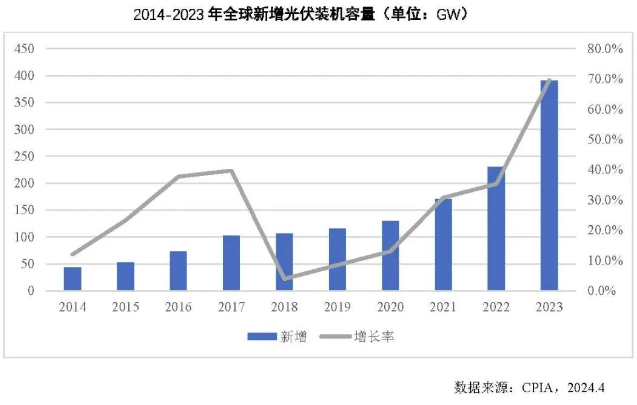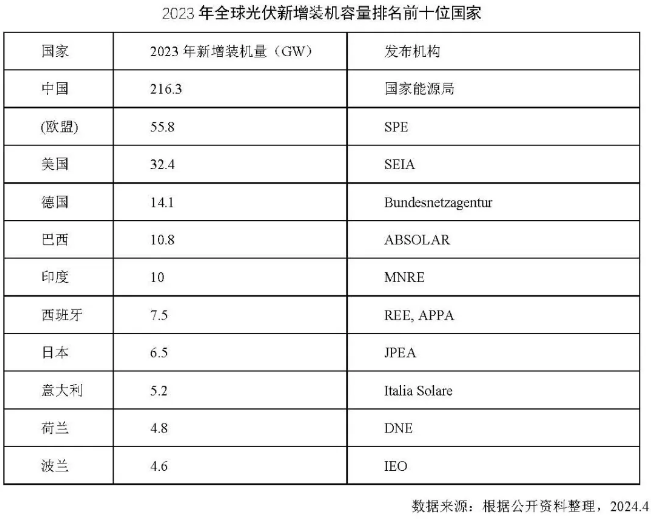1. Algemene situatie van de mondialefotovoltaïsche markt voor toepassingen in 2023
In 2023 zal de mondiale fotovoltaïsche geïnstalleerde capaciteit 390 GW bedragen, een jaar-op-jaar stijging van 69,6%, en de cumulatieve geïnstalleerde capaciteit zal ongeveer 1546 GW bedragen. In 2023 zal de mondiale fotovoltaïsche geïnstalleerde capaciteit een nieuw hoogtepunt bereiken.

In 2023 zal China nog steeds zijn leidende positie behouden op de mondiale markt voor nieuwe geïnstalleerde capaciteit, met een jaarlijkse nieuwe geïnstalleerde capaciteit van 216,3 GW aan de AC-zijde, wat een nieuw historisch hoogtepunt betekent. De nieuwe fotovoltaïsche geïnstalleerde capaciteit is sinds 2013 elf jaar op rij de eerste ter wereld gebleven. In 2023 zal de nieuwe fotovoltaïsche geïnstalleerde capaciteit van China de helft van de nieuwe geïnstalleerde capaciteit in de wereld overschrijden. en de cumulatieve geïnstalleerde capaciteit zal bijna 40% van de wereld uitmaken.

2. Veranderingen in het beleid op de belangrijkste fotovoltaïsche markten
(1) De Verenigde Staten ontwikkelen lokale zonne-energie over de hele industriële keten
De afgelopen jaren hebben de Verenigde Staten een aantal grote wetsvoorstellen aangenomen en uitgevaardigd, waaronder de Infrastructure Investment and Jobs Act, de Buy American Act en de Inflation Reduction Act, in een poging de ontwikkeling van lokale zonne-energie te bevorderen door de investeringen te verhogen op het gebied van onderzoek en innovatie, het versterken van het concurrentievermogen van de lokale industrie, het vergroten van het enthousiasme voor marktinvesteringen en het versnellen van de ontwikkeling en het gebruik van projecten. Gestimuleerd door relevant beleid blijft de geïnstalleerde capaciteit voor de opwekking van zonne-energie in de Verenigde Staten groeien. Volgens statistieken van de Photovoltaic Industry Association (SEIA) zal de cumulatieve geïnstalleerde capaciteit van fotovoltaïsche zonne-energie in de Verenigde Staten in 2023 179 GW bereiken, met een gemiddelde groei van 22% over de afgelopen tien jaar.
Aan de productiekant stimuleerde de Inflation Reduction Act ook de ontwikkeling van de lokale fotovoltaïsche productie-industrie, en de productiecapaciteit van lokale componenten is toegenomen van 8 GW in 2022 tot meer dan 12 GW nu. Sinds 2023 hebben bedrijven als JA Solar, LONGi Green Energy, JinkoSolar, TCL Zhonghuan, Canadian Solar en Trina Solar de bouw van overzeese productiecapaciteit versneld, geïntegreerd in het regionale industriële ketensysteem, en investeringen aangekondigd in fotovoltaïsche productieprojecten in de regio. Verenigde Staten. Tegen 2026 zal de binnenlandse productiecapaciteit van Amerikaanse componenten naar verwachting 123 GW bereiken. Er zijn echter verschillende moeilijkheden en uitdagingen, van de planning tot de daadwerkelijke uitvoering en vervolgens tot de implementatie van het project. Als gevolg van verschillende problemen, zoals financiering, productie-ervaring, concurrentie op de markt, technologie en grondstoffen, is het grootste deel van de nieuwe productiecapaciteit moeilijk te implementeren.
(2) De EU ondersteunt fotovoltaïsche energie productie en versterkt de veerkracht van de toeleveringsketen
In 2022 is REPowerEU van plan het aandeel van het hernieuwbare energieverbruik verder te verhogen tot 45%, en de geïnstalleerde capaciteit van hernieuwbare energie kan 1236 GW bereiken. Onder hen stelt de "EU Solar Strategy", als onderdeel van dit plan, het ontwikkelingsdoel van nieuwe fotovoltaïsche geïnstalleerde capaciteit van meer dan 320 GW in 2025 en meer dan 600 GW in 2030. Op 16 maart 2023 heeft de Europese Commissie de “Net Zero Industry Act” en de “Critical Raw Materials Act” wetsvoorstellen voorgesteld, waarin werd bepaald dat tegen 2030 de binnenlandse koolstofvrije economie van de EU De productiecapaciteit van de technologie moet 40% bereiken. Tegelijkertijd wordt, om het vermogen van de EU om strategische grondstoffen te winnen, te verwerken en te recyclen, ook bepaald dat tegen 2030 10% van de strategische grondstoffen in de EU zal worden gewonnen, en nog eens 15% van de cruciale grondstoffen van de EU grondstoffen zullen strikt worden gerecycled. Vanuit het perspectief van beleidsmaatregelen omvatten deze voornamelijk het optimaliseren van het projectlicentieproces, het bieden van financiële steun, het versterken van het aanbod van talent, het verbeteren van de transparantie van productinformatie, het implementeren van koolstoftarieven en industriële subsidies, enz.
(3) India streeft ernaar de ontwikkeling van de binnenlandse fotovoltaïsche industrie te bevorderen
In 2022 heeft India officieel zijn "Nationaal bepaalde bijdrage", gebaseerd op het Klimaatakkoord van Parijs, bijgewerkt, waarbij het beloofde de CO2-emissie-intensiteit van zijn bbp tegen 2030 met 45% te verminderen ten opzichte van het niveau van 2005; met behulp van technologieoverdracht en goedkope internationale financiering, waaronder het Groene Klimaatfonds (GCF), zal de cumulatieve geïnstalleerde capaciteit van niet-fossiele energie tegen 2030 50% van de totale capaciteit bereiken, de geïnstalleerde capaciteit van niet-fossiele energie zal 500 GW bereiken, waarvan zonne-energie 280 GW zal opleveren. Tegelijkertijd heeft de Indiase regering ook een aantal protectionistische beleidsmaatregelen aangenomen voor de fotovoltaïsche industrie. Eerst werd het Basis Douanerecht (BCD) ingevoerd. Vanaf 1 april 2022 zal de regering een basistarief van 25% opleggen voor geïmporteerde fotovoltaïsche zonnecellen en een basistarief van 40% voor geïmporteerde fotovoltaïsche zonnepanelen. Op 29 maart 2024 kondigde het Ministerie van Nieuwe en Hernieuwbare Energie (MNRE) van India aan dat de ALMM-lijst voor zonne-PV-modules vanaf 1 april 2024 van kracht zou moeten worden.
 online dienst
online dienst +86 (0592)5663849
+86 (0592)5663849 sales@uisolar.com
sales@uisolar.com solar-mount.au
solar-mount.au